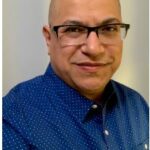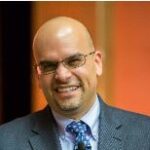Recently, El Futuro’s Executive Director, Dr. Luke Smith, and Duke Resident Dr. Andres Fuenmayor hosted a webinar for El Futuro’s La Mesita Network of Mental Health Providers on the subject of Lifestyle Mental Health. It was a rich conversation that covered many of the emerging studies of the relatively new medical subspecialty of Lifestyle Medicine and gave practical tips on how to integrate the six pillars into clinical mental health practice with the Latino community.
Here are some of the highlights from the conversation.
What is Lifestyle Medicine and why are we hearing about it these days?
- Luke Smith (LS): Dr. Fuenmayor and I attended the 2024 Mental Health Services Conference in Baltimore last November where they were focusing on Lifestyle Medicine, and it was then that I realized Lifestyle Medicine is becoming a significant medical subspecialty. Lifestyle Medicine has six pillars or domains, which are restorative sleep, whole food more plant-based nutrition, physical activity, stress management, positive social connection, and avoiding risky substances. I realized that these were pillars that I had increasingly focused on in my practice, and the evidence has been growing by leaps and bounds. It made me feel better about my practice.
Why are you hopeful about Lifestyle Medicine?
- Andres Fuenmayor (AF): In medicine, too many times, we focus on a problem that needs to be fixed or solved, but this is an effective way to also prevent problems in the future.
- LS: Yes, this is significant for someone like me – a psychiatrist – who thinks about prescribing prescriptions. To see people who are treatment non-responders become treatment responders because of some adjustments to their lifestyle, is very empowering. The evidence is so impressive that it is surging like a tide and a lot of things are starting to point in this direction.
What is some of the evidence that most excites you?
- LS: One meta-analysis of 18 studies of 1,354 older adults showed that exercise training significantly reduced depressive symptoms. Another systematic review of 21 studies of 87,508 adults showed that increased muscular strength was associated with reduced depression symptoms. By the way, did you know that one of the ways that they measure muscular strength is with hand grip? What I’m learning is that strength training has a greater effect on depression, so I can see my clinical approach shifting with this new data. For instance, now, when I think about depression, I think about strength training. When I think about anxiety, I think about cardio. In another study on the effect of resistance training on depression, they found that the number Needed to Treat with resistance training for 1 patient to enter remission was 4. That was equal to or better than many medications that are used for depression. It makes me think we need to set up gyms in all our mental health clinics! The Lifestyle Medicine Pillar of diet is also very significant. Numerous studies like the SMILES trial, HELFIMED study, and others have shown that switching people to Mediterranean Diets are not only good for physical health but also for mental health. The results are consistently showing impressive benefits as early as 3 weeks to 3 months after switching, even for those who are taking medications or therapy and haven’t shown improvement. Those individuals are getting better just from changing their diets. The key appears to be eliminating processed foods, shifting to less animal products and increasing consumption of plants.
Does Lifestyle Medicine help more severe diagnoses like PTSD or schizophrenia?
- LS: Yes, it can help with more severe diagnoses. In one study of inpatients with PTSD, one group was assigned to a 12-week exercise program, which was a 30-minute session of progressive resistance training and walking with a 10,000 step goal three times a week. The exercise group had a significant reduction in PTSD symptoms. With schizophrenia, studies are showing that positive symptoms like hallucinations and paranoia can be reduced by resistance exercise, whereas negative symptoms like depression and anhedonia can be reduced by resistance training and cardio. This has changed my clinical practice. Usually, we are pretty good at using medicine to treat positive symptoms of schizophrenia to reduce hallucinations and paranoia, but we are often left with a patient who has the negative symptoms, and they are still depressed. But then we come to studies like this and see that exercise helps. That’s significant, and we can’t ignore it.
If the evidence is so compelling, why aren’t more clinicians promoting Lifestyle Medicine in their treatment plans?
- LS: Some of the things you hear about the concept of lifestyle medicine can make you suspicious. You may ask yourself, is that real or is that science? In general, I think many of us feel like there’s an evidence base, but we don’t practice it enough yet. In fact, we did a survey of our clinicians to ask what barriers keep them from talking about Lifestyle Medicine in their clinical spaces and, as we expected, a perceived lack of client motivation and resources was towards the top of the list. However, the number one reason they identified was insufficient training on the subject! It is a relatively new field in regard to the material coming together in textbooks, so it’s a little bit of a challenge to start implementing it. Studies show it takes 17 years for research evidence to reach clinical practice. So, we are learning together. Another important barrier is the perception that it is more expensive to eat well. However, researchers found that creating meals from the MedDiet (Mediterranean Diet) represented an $18 decrease on groceries per week, but the bigger barrier was probably the time for food prep. So that’s where grocery list and meal prep hand-outs can help.
It may seem obvious that a good diet and regular exercise are just what the doctor ordered. But what about the pillar of social connection? What role does that play?
- LS: Loneliness is a really big thing. People who are marginalized are more likely to be caught up in the epidemic of loneliness. Loneliness and social isolation increase the risk of developing dementia by up to 50% in older adults. And social isolation is the strongest and most reliable predictor of suicidal ideation, attempts, and lethal suicidal behavior. Conversely, socialization is associated with up to 15% reduction in depression! So, it works!
Still, social connection seems like a more nuanced pillar. It requires a social infrastructure that encourages people to spend time together. How can we, as a society, do better to confront this epidemic of loneliness?
- LS: There are some amazing examples of communities finding creative ways to address this. My colleague Mary Jones just told me about a Friendship Bench project in Zimbabwe to treat depression. That project is centered around people getting trained to have substantial conversations with others on common public benches and sitting spaces. I think the reason we don’t see friendship bench methods in the US is because insurance won’t pay for it. To see a friendship bench outside of every school and clinic and have people motivated to use this technique would be awesome! At El Futuro, we have an outside park with benches and places for people to come together. I recall another example from the book, Palaces of the People, which looked at elderly people in New York City who weren’t socializing and so they started a Wii bowling group in public places like libraries. This group wasn’t physically able to bowl, but they could do it through the Wii and it turned into a fun and active community. The imagination and freshness of that makes me think – what else?! It’s never impossible. Let’s get together. Let’s problem-solve. Those are ways that I react to that question.
How do you apply these learnings in working with the Latino community?
- AF: When you work with the Hispanic community, you have to take certain features into consideration in order to make sure you have higher indicators of success. Things like Familismo (the importance of family), Personalismo (warmth and personal connections), Respeto (respect), Simpatia (harmonious relationships), Economic and environmental barriers, and traditional foods and practices. First generation immigrants are more rooted to their food and culture for instance. So we take into account cultural considerations when working with a Latino family.
What ideas does El Futuro recommend to help clients integrate Lifestyle Medicine into their mental health treatment?
- AF: Therapeutic groups are a great start because they incorporate peer education on the topic, promote social connection, and enhance accountability. Other suggestions include identifying local free exercise or Zumba classes. One of the first things our Substance Use counselors do is to help a new client get connected to a local soccer league if that is a passion of theirs. Therapists can also work with a client to build skills in real time, like looking together at the “added sugars” on drinks and discussing how this could be impacting their treatment. We just want to be careful that there is never an element of shaming in the approach we take.
How do you avoid shaming when discussing Lifestyle Medicine approaches?
- AF: It helps to empower instead of to prescribe. We have to respect their autonomy. Clinicians may have the best intentions, but clients are the ones who have to live their lives and make their own decisions. So, we will often use a technique called Motivational Interviewing, where we begin by asking permission to talk to them about these elements. Most of the time, clients come to our office because they are ready for a change. We can use that motivation as an anchor to give them tools. I try not to recommend changes in the first visit. I try to gather information about them and share information about myself so we can ground ourselves together.
How do you recommend that clinicians begin to integrate Lifestyle Medicine into their work with a client?
- AF: Several ideas come to mind. First, clinicians should focus on small, achievable goals that will stimulate a person’s reward system so that these changes keep happening, and also link the changes to their values so they will have their own buy-in. Also, a clinician should normalize ambivalence. For instance, I had a patient who felt nervous about going into group therapy. That’s hard, I said. Going into a new space with vulnerability is hard. We should also highlight autonomy and emphasize that a client is in control of their decisions and they may not be ready to make a change. Finally, I always like to share brief success stories from others who have made similar changes. This topic is close to my heart because I don’t recommend things to clients that I haven’t seen or used. I want to replicate what I see that works.
Do you have any resources to share?
- AF: The Lifestyle Medicine website has some great multilingual resources available at their website (link here). But we need to develop more in video format and with less words for people who aren’t as literate. There is work to do in this area.
Learn more about El Futuro’s La Mesita program here.

 Alvely Alcántara, LCSW
Alvely Alcántara, LCSW Rossy C. Garcia, MEd
Rossy C. Garcia, MEd  Katy Sims, MD
Katy Sims, MD  Everardo Aviles, LCSW, LCAS (Eve)
Everardo Aviles, LCSW, LCAS (Eve) As a medical anthropologist and social work researcher, Dr. Gulbas’ research embodies interdisciplinarity through the integration of applied theories of health and human development with qualitative and ethnographic methodologies. Her work seeks to understand how people—children, families, and providers—navigate complex sociocultural landscapes in the pursuit of mental health. Most of her work, to date, focuses attention on developing more robust interpretations of suicide risk. With funding from the National Institutes of Mental Health, this body of research has contributed to advancements in theoretical and empirical knowledge of the broader contexts within which youth suicide risk is situated.
As a medical anthropologist and social work researcher, Dr. Gulbas’ research embodies interdisciplinarity through the integration of applied theories of health and human development with qualitative and ethnographic methodologies. Her work seeks to understand how people—children, families, and providers—navigate complex sociocultural landscapes in the pursuit of mental health. Most of her work, to date, focuses attention on developing more robust interpretations of suicide risk. With funding from the National Institutes of Mental Health, this body of research has contributed to advancements in theoretical and empirical knowledge of the broader contexts within which youth suicide risk is situated.  R. Gabriela Barajas-Gonzalez is a developmental psychologist and an assistant professor of Population Health at NYU Grossman School of Medicine. Dr. Barajas-Gonzalez is the principal investigator of a study that examines the impact of immigration-related threat and stress on school communities. She earned a PhD in developmental psychology from Columbia University and hold a BA in human biology from Stanford University. Dr. Barajas-Gonzalez is the daughter of Mexican immigrants and a first gen college student.
R. Gabriela Barajas-Gonzalez is a developmental psychologist and an assistant professor of Population Health at NYU Grossman School of Medicine. Dr. Barajas-Gonzalez is the principal investigator of a study that examines the impact of immigration-related threat and stress on school communities. She earned a PhD in developmental psychology from Columbia University and hold a BA in human biology from Stanford University. Dr. Barajas-Gonzalez is the daughter of Mexican immigrants and a first gen college student. Dr. Parra-Cardona is an Associate Professor in the Steve Hicks School of Social Work (SHSSW) at the University of Texas at Austin. At the SHSSW, he serves as Coordinator for Mexico and Latin American initiatives. He also serves as Area Director for Research at the UT Austin Latino Research Institute. Dr. Parra-Cardona’s program of research is focused on the cultural adaptation of evidence-based parenting interventions for low-income Latinx populations in the US and Latin America.
Dr. Parra-Cardona is an Associate Professor in the Steve Hicks School of Social Work (SHSSW) at the University of Texas at Austin. At the SHSSW, he serves as Coordinator for Mexico and Latin American initiatives. He also serves as Area Director for Research at the UT Austin Latino Research Institute. Dr. Parra-Cardona’s program of research is focused on the cultural adaptation of evidence-based parenting interventions for low-income Latinx populations in the US and Latin America. Bianka Reese, PhD, MSPH is a research scientist and program evaluator specializing in adolescent and young adult sexual and reproductive health. Her previous research in the experiences of Latinx LGBTQ+ youth stems from her work as the Research and Evaluation Manager at SHIFT NC (Sexual Initiatives For Teens), where she led largescale evaluations of multilevel, community-based sexual health promotion initiatives and research projects aimed at elevating the voices of diverse youth in North Carolina. Dr. Reese is currently the Senior Research Strategist at Creative Research Solutions, LLC, an award-winning national evaluation, research, and assessment firm.
Bianka Reese, PhD, MSPH is a research scientist and program evaluator specializing in adolescent and young adult sexual and reproductive health. Her previous research in the experiences of Latinx LGBTQ+ youth stems from her work as the Research and Evaluation Manager at SHIFT NC (Sexual Initiatives For Teens), where she led largescale evaluations of multilevel, community-based sexual health promotion initiatives and research projects aimed at elevating the voices of diverse youth in North Carolina. Dr. Reese is currently the Senior Research Strategist at Creative Research Solutions, LLC, an award-winning national evaluation, research, and assessment firm. Tania Connaughton-Espino, MPH is an independent researcher focused on adolescent and young adult sexual and reproductive health. Her interest in the experiences of Latinx LGBTQ+ youth stems from her previous work with SHIFT NC (Sexual Initiatives For Teens), where she led the training and evaluation department, conducted capacity-building workshops for youth serving professionals including on the topic of how to be more affirming of LGBTQ youth, and from her extensive experience working with the Latinx population in NC.
Tania Connaughton-Espino, MPH is an independent researcher focused on adolescent and young adult sexual and reproductive health. Her interest in the experiences of Latinx LGBTQ+ youth stems from her previous work with SHIFT NC (Sexual Initiatives For Teens), where she led the training and evaluation department, conducted capacity-building workshops for youth serving professionals including on the topic of how to be more affirming of LGBTQ youth, and from her extensive experience working with the Latinx population in NC. Maru Gonzalez, EdD is an Assistant Professor and Youth Development Specialist in the Department of Agricultural and Human Sciences at North Carolina State University. Her areas of inquiry include youth development with a focus on activism, social justice, and the experiences of LGBTQ+ young people across familial, school, and community contexts.
Maru Gonzalez, EdD is an Assistant Professor and Youth Development Specialist in the Department of Agricultural and Human Sciences at North Carolina State University. Her areas of inquiry include youth development with a focus on activism, social justice, and the experiences of LGBTQ+ young people across familial, school, and community contexts.  Nayeli Y. Chavez-Dueñas, PhD
Nayeli Y. Chavez-Dueñas, PhD Hector Y. Adames, PsyD
Hector Y. Adames, PsyD